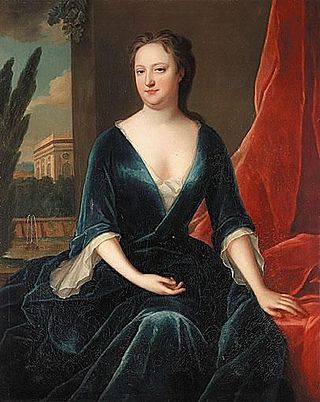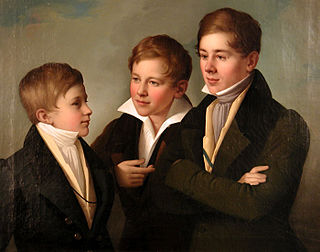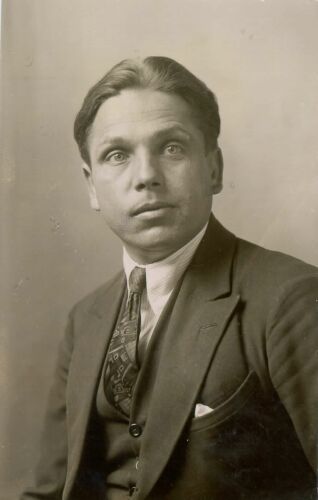
Ivana Kobilca is the most prominent Slovene female painter and a key figure of Slovene cultural identity. She was a realist painter who studied and worked in Vienna, Munich, Paris, Sarajevo, Berlin, and Ljubljana. She mostly painted oil paintings and pastels, whereas her drawings are few. The themes include still life, portraits, genre works, allegories, and religious scenes. She was a controversial person, criticized for following movements that had not developed further in later periods.

Gerard van Honthorst was a Dutch Golden Age painter who became known for his depiction of artificially lit scenes, eventually receiving the nickname Gherardo delle Notti. Early in his career he visited Rome, where he had great success painting in a style influenced by Caravaggio. Following his return to the Netherlands he became a leading portrait painter. Van Honthorst's contemporaries included Utrecht painters Hendrick Ter Brugghen and Dirck van Baburen.

The Art of Painting, also known as The Allegory of Painting, or Painter in his Studio, is a 17th-century oil on canvas painting by Dutch painter Johannes Vermeer. It is owned by the Austrian Republic and is on display in the Kunsthistorisches Museum in Vienna.

Flemish painting flourished from the early 15th century until the 17th century, gradually becoming distinct from the painting of the rest of the Low Countries, especially the modern Netherlands. In the early period, up to about 1520, the painting of the whole area is typically considered as a whole, as Early Netherlandish painting. This was dominated by the Flemish south, but painters from the north were also important. Dutch and Flemish Renaissance painting, of which Antwerp became the centre, covers the period up to about 1580 or later, by the end of which the north and south Netherlands had become politically separated. Flemish Baroque painting was especially important in the first half of the 17th century, dominated by Rubens.

Theodoor Rombouts was a Flemish painter who is mainly known for his Caravaggesque genre scenes depicting lively dramatic gatherings as well as religiously-themed works. He is considered to be the primary and most original representative of Flemish Caravaggism. These Caravaggisti were part of an international movement of European artists who interpreted the work of Caravaggio and the followers of Caravaggio in a personal manner.

Jan Miense Molenaer, was a Dutch Golden Age genre painter whose style was a precursor to Jan Steen's work during Dutch Golden Age painting. He shared a studio with his wife, Judith Leyster, also a genre painter, as well as a portraitist and painter of still-life. Both Molenaer and Leyster may have been pupils of Frans Hals.

JohannesLingelbach (1622–1674) was a Dutch Golden Age painter, associated with the second generation of Bambocciate, a group of genre painters working in Rome from 1625–1700.

The National Gallery of Armenia is the largest art museum in Armenia. Located on Yerevan's Republic Square, the museum has one of the most prominent locations in the Armenian capital. The NGA houses significant collections of Russian and Western European art, and the world's largest collection of Armenian art. The museum had 65,000 visitors in 2005.

The National Gallery of Slovenia is the national art gallery of Slovenia. It is located in the capital Ljubljana. It was founded in 1918, after the dissolution of Austria-Hungary and the establishment of the State of Slovenes, Croats and Serbs. Initially, it was hosted in the Kresija Palace of Ljubljana, but moved to the present location in 1925.
Zvest Apollonio was a Slovenian painter and scenographer.
Herman Gvardjančič, is a Slovene painter.

Pieter Harmensz Verelst was a Dutch Golden Age painter. Three of his sons, Simon, Herman, and Johannes Verelst, also became painters.

Herman Verelst, was a Dutch Golden Age painter.

A Man with a Quilted Sleeve is a painting of about 1510 by the Venetian painter Titian in the National Gallery, London, measuring 81.2 by 66.3 centimetres. Though the quality of the painting has always been praised, there has been much discussion as to the identity of the sitter. It was long thought to be a portrait of Ariosto, then a self-portrait, but in 2017 is called Portrait of Gerolamo (?) Barbarigo by the gallery, having also been called merely Portrait of a Man, the title used here, The Man with the Blue Sleeve, and no doubt other variants.

Maria Verelst (1680–1744) was an 18th-century English painter.

Art of Slovenia refers to all forms of visual art in or associated with Slovenia, both before and after the country's Independence from Yugoslavia in 1991. Art in Slovenia has been shaped by a number of Slovenian painters, sculptors, architects, photographers, graphics artists, comics, illustration, and conceptual artists. The most prestigious institutions exhibiting works of Slovene visual artists are the National Gallery of Slovenia and the Museum of Modern Art in Ljubljana.
The Jakopič Pavilion was an art gallery in Ljubljana, the first purpose-built art exhibition venue in the territory of modern Slovenia. It was built in 1908 by the painter Rihard Jakopič upon the plans of the architect Max Fabiani. The pavilion stood at the beginning of the Latterman Avenue in Tivoli Park. Until World War II, it was the central exhibition place of Slovene visual artists, presenting exhibitions from the fields of painting, sculpture and photography.
The year 2015 in art involves various significant events.

Lojze Dolinar was a Slovenian sculptor recognized for his impact on local and global 19th and 20th century art. When he moved to America he worked in architectural plastic art and thereafter in antique and modern art. In 1931 he went to Belgrade and between World War I and World War II he became one of the most sought-out monument sculptors. In 1946 he joined the Belgrade Fine Arts Academy and three years later got a professorship there. Among others he was taught by Alojzij Repič and worked with Jože Plečnik.

Franc Berneker was a 19th- and early-20th-century Slovene tomb sculptor, who had a strong impact on Slovenj Gradec gaining recognition for his work in bronze, marble and monuments. His art focus went from realism to modernism to psychology, drama and an exploration of the relationship between worked and unworked, smooth and rough. He studied with Edmund von Hellmer at the Vienna Academy of Fine Arts and Ivan Zajec on monuments of national heroes His art work is displayed at the Resau Art Nouveau Network.
















